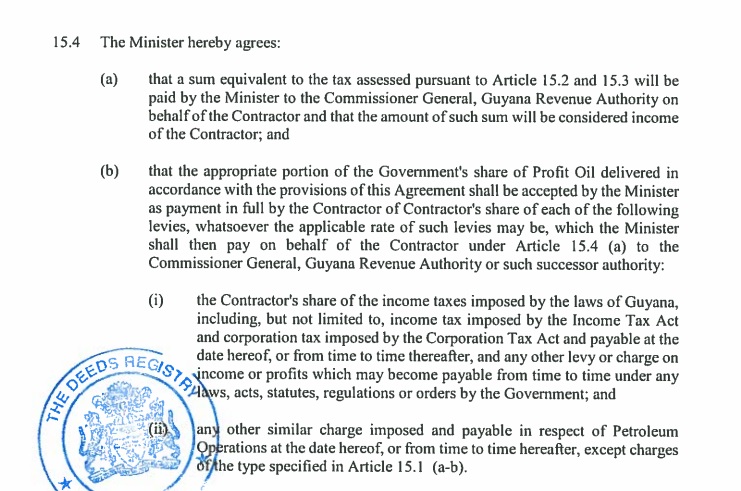Guyana gives up entire year’s budget paying Exxon & partners Income Tax
News
Kaieteur News – Oil is a tricky business and Guyana has found itself in a conundrum where it is foregoing more than it earns, meaning the oil business is essentially running at a loss for the country.

Hess Corporation CEO, John Hess
According to the Production Sharing Agreement (PSA), Guyana has agreed to, under the taxation provisions, to pay ExxonMobil’s share of Corporation and Income Tax.
As such it would mean, that Guyana foregoes each year, billions of US dollars. Clause 15.4 (a) of that PSA stipulates that the Minster of Natural Resources agrees that a sum equivalent to the tax assessed to be paid by the Minister to the Commissioner General of the Guyana Revenue Authority (GRA) on behalf of the contractor—ExxonMobil Guyana – and that the amount of such sum will be considered income of the contractor.
Additionally, at 15.4 (b) the Minister also agrees that the appropriate portion of the Government’s share of profit oil delivered, shall be accepted as payment in full for the contractor’s share of Income Tax and Corporation Tax—levies owed to the GRA.

Minister within the Office of the President with responsibility for Finance, Dr. Ashni Singh
Collectively it would mean that instead of Esso Exploration and Production Guyana Limited (EEPGL)—ExxonMobil Guyana—paying over hundreds of millions of US dollars annually as taxes owed to GRA, it has agreed to accept that a portion of its share of profit oil, be recognised as its taxes. Documentation to this effect is then provided to the US based company allowing it to not have to pay any taxes in its home country for its earnings overseas.
Collectively, this has led to Guyana’s financial records being essentially misrepresented to reflect profits from an industry when in fact the country is in the red losing hundreds of millions by foregoing the payment of Income and Corporation Tax.
Addressing the forgone Income Tax alone, juxtaposed with Guyana’s earnings on Profit Oil and its two percent royalty would expose that Guyana will in fact lose in excess of $2B this year.

The applicable section of the PSA
This, since calculated at 25 percent of its earnings, Income Tax foregone would easily eclipse Guyana’s earnings.
This year, Minister within the Office of the President, with responsibility for Finance, Dr. Ashni Singh has predicted that Guyana will be collecting some US$957M this year—US$857 being profit and US$100M being royalty.
ExxonMobil partner in the Stabroek Block, John Hess, Chief Executive Officer of Hess Corporation recently pegged earnings from the oil block this year to be some US$2.6B for its 30 percent stake in the operations.
The Stabroek Block is currently being developed by two Floating Production Storage and Offloading (FPSO)—the Liza Destiny and Unity and the Liza I and II developments—and collectively the oil companies are set to rake in just under US$9B.
As such, it would mean that should Guyana collect, its Income Tax from ExxonMobil and their partners this year, at 25 percent, it would see Guyana earning some US$2.25B on Income Tax alone.
But with Guyana agreeing to pay that tax bill to GRA from its less than US$1B earnings, it would mean that the Ministry of Natural Resources would still owe GRA some US$1.3B, to be paid from future earnings.
Conversely, it would mean that Guyana will lose US$2.25B it should have collected as Income Tax from the oil companies.
The revelation of the oil companies earnings from the Stabroek Block by Hess Corporation’s CEO, John Hess, was made during his recent participation at the Bernstein’s 38th Annual Strategic Decisions Conference.
During an almost one-hour discussion that was focused mostly on Guyana, he said the company has already received three lifts of one million barrels of oil from the Stabroek Block, which has two ongoing projects, Liza Phase One and Liza Phase Two.
In the second quarter, he said the lifts will increase to seven and in the third and fourth quarters, eight liftings each. The Hess Boss said, “We have over a US$100 barrel price. We are therefore going from US$300M of incremental cash flow from Guyana to US$700M in the second quarter, then US$800M in the third and US$800M in the fourth.
Dr. Singh during the reading of budget 2022 earlier this year had said that there will be 94 lifts from the Stabroek Block, 13 of which will be government’s lifts.
From this, it is estimated that deposits into the Natural Resource Fund for 2022 will total US$957.6 million, comprising some US$857.1 million earned from the government lifts of profit oil, and an additional US$100.5 million from royalties.
By Kaieteur News’ calculations, Exxon’s subsidiary and operator of the Stabroek Block, EEPGL, is poised to walk away with US$3.9B while CNOOC will get US$2.2B this year. It therefore means that Exxon and partners will walk away with US$8.7B profit in 2022 tax-free.
The Liza Phase I development, which began production in December 2019 utilising the Liza Destiny FPSO with a production capacity of approximately 120,000 gross barrels of oil per day, recently completed production optimisation work that expanded its production capacity to more than 140,000 gross barrels of oil per day.
The Liza Phase II development, utilising the Liza Unity FPSO, began production in February 2022 and is expected to reach its production capacity of approximately 220,000 gross barrels of oil per day by the third quarter.
The third development at Payara is ahead of schedule and now expected to come online in late 2023, utilising the Prosperity FPSO with a production capacity of approximately 220,000 gross barrels of oil per day.
The fourth development, Yellowtail, is expected to come online in 2025, utilising the ONE GUYANA FPSO with a production capacity of approximately 250,000 gross barrels of oil per day. At least six FPSOs with a production capacity of more than one million gross barrels of oil per day are expected to be online on the Stabroek Block in 2027, with the potential for up to 10 FPSOs to develop gross discovered recoverable resources. Guyana’s Stabroek Block is 6.6 million acres (26,800 square kilometres). ExxonMobil affiliate Esso Exploration and Production Guyana Limited is the operator and holds 45 percent interest in the Block. Hess Guyana Exploration Ltd. holds 30 percent interest, and CNOOC Petroleum Guyana Limited holds 25 percent interest.


